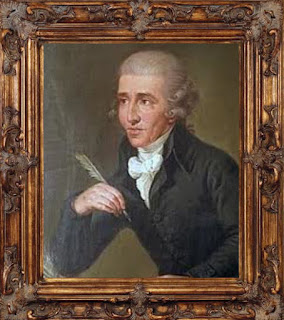.jpg) Joseph Haydn worked as a hand to mouth free-lance composer after he was dismissed as a chorister when his voice broke in 1749. His circumstances became more secure when he was hired as Kappellmeister by Count Moritz, a member of the Austrian aristocracy, in 1756. This employment lasted until the Count's finances dried up in 1761 and he had to dismiss his musicians. By this time Haydn had made enough of a name for himself that Prince Paul Anton, the head of the wealthy Esterházy family, hired him as Assistant Kappellmeister. Haydn was hired as full Kappellmeister in 1766. Haydn remained as a full-time employee of the Esterházy family until 1790 when he was offered a salary and a pension, still in the employ of the family but with the freedom to travel and live where he chose.
Joseph Haydn worked as a hand to mouth free-lance composer after he was dismissed as a chorister when his voice broke in 1749. His circumstances became more secure when he was hired as Kappellmeister by Count Moritz, a member of the Austrian aristocracy, in 1756. This employment lasted until the Count's finances dried up in 1761 and he had to dismiss his musicians. By this time Haydn had made enough of a name for himself that Prince Paul Anton, the head of the wealthy Esterházy family, hired him as Assistant Kappellmeister. Haydn was hired as full Kappellmeister in 1766. Haydn remained as a full-time employee of the Esterházy family until 1790 when he was offered a salary and a pension, still in the employ of the family but with the freedom to travel and live where he chose.Haydn's duties as Kappellmeister were many. He must have been a very well-organized and disciplined person, as he was responsible for anything that pertained to music. Among his responsibilities were the hiring, training and firing of musicians, upkeep and maintenance of the musical instruments, acquiring and maintaining the musical library, the staging of operas, rehearsing and conducting the orchestra as well as playing the organ and keyboard. And on top of all that, he was also expected to compose music. Operas, symphonies, concertos, chamber music (including 175 chamber compositions for various instrument combinations that included the Prince's instrument of choice, the Baryton, a type of bowed gamba with an extra set of plucked strings). While he was highly respected, he was still considered a member of the servant staff and wore a livery uniform. By contemporary accounts, Haydn's temperament was mild. He was humble by nature, subservient to his employers and had a good sense of humor. He was fair with the musicians in his charge which led them to respect him. The only recorded flaw in his character was greed. After he was allowed to accept commissions for compositions from other patrons besides the Esterházy family, his concern was to make as much money as he could the best way that he could. But looked at a different way, Haydn may not have been greedy so much as wanting to build up financial security after he had suffered from poverty in his earlier years.
His 47th Symphony in G Major was written about 1772, a time when his imagination and craftsmanship worked together to create a symphonic style that was to set the standard for symphonic composition. The symphony is in 4 movements and is considered one if his Sturm und Drang symphonies, although Haydn never used the term himself. The nickname 'palindrome' comes from the 3rd movement minuet which is discussed below:
I. Allegro - The first theme resembles a march and is announced by the dotted rhythms of the horns. The second subject by contrast is free from the dotted rhythm and flows more readily. The exposition is repeated. The development section has the march theme dominate, and by the use of key changes it grows more passionate and tense. The second theme is commented on and leads to the recapitulation. Here Haydn throws the listener a curve, for instead of the first theme appearing in the major key of the beginning, it appears in a minor key. The second theme is played in the home key and as was customary in this era, the section is repeated.
II. Un poco adagio cantabile - A set of 4 variations on a theme in invertible counterpoint, an example of Haydn's mastery of counterpoint that he learned by studying the music of C.P.E. Bach and working his way through the counterpoint exercises of Gradus ad Parnassum by Johann Joseph Fux.
III. Menuetto e trio, Menuetto al Roverso - The movement that gives this symphony its nickname. A palindrome is a word, phrase, or number that reads the same backward or forward. In this case, it is music that is played forwards, then backwards. The minuet is in two parts, and Haydn directs the musicians to play each part twice to the double bar, then twice in reverse. The trio is directed to do the same:
Haydn pulls off a piece of subtle musical trickery, kind of an inside joke that wouldn't be detected by the casual listener. Through the use of accents and the melodies themselves, Haydn accomplishes his inside joke while making the music make sense. This movement was supposedly a favorite of Mozart's.
IV. Presto assai - A fast-paced movement with a sprinkling of dissonance to good effect. A rousing finale to a unique symphony.







.jpg)


















.jpg)


